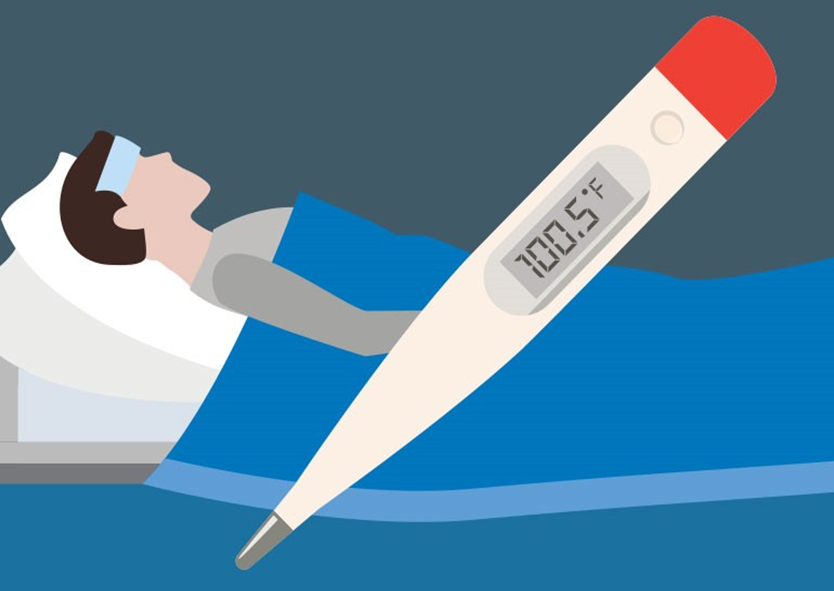Which of the following is the most reliable early indicator of infection in a client with low WBC?
Fever
Chills
Tachycardia
Dyspnea
The Correct Answer is A
Choice A rationale:
Fever is the most reliable early indicator of infection in a client with low WBC because it is a direct physiologic response to the presence of pathogens. When the body detects an infection, it releases pyrogens, which act on the hypothalamus to raise the body's temperature. This elevated temperature helps to create an environment that is less hospitable to bacteria and viruses, and it also stimulates the immune system to fight the infection.
In clients with low WBC, the immune system is already compromised, so the fever response may be even more pronounced. It's important to note that even a slight elevation in temperature (as low as 100.4°F or 38°C) can be significant in these clients.

Choice B rationale:
Chills can also be a sign of infection, but they are not as specific as fever. Chills can occur for other reasons, such as exposure to cold or anxiety.
Choice C rationale:
Tachycardia, or increased heart rate, can also be a sign of infection, but it is not as reliable as fever. Tachycardia can occur for other reasons, such as dehydration, pain, or anxiety.
Choice D rationale:
Dyspnea, or shortness of breath, is not a typical early sign of infection. It is more likely to occur in later stages of infection, when the infection has spread to the lungs.
Nursing Test Bank
Naxlex Comprehensive Predictor Exams
Related Questions
Correct Answer is A
Explanation
Choice A rationale:
Serum creatinine is a waste product that is produced by muscle metabolism and is normally excreted by the kidneys.
When kidney function is impaired, creatinine levels in the blood increase, making it a sensitive and specific indicator of renal function.
It is considered one of the most reliable markers for assessing kidney function and is routinely used to screen for and monitor kidney disease.
Choice B rationale:
Serum sodium is an electrolyte that is regulated by the kidneys, but it is not a direct measure of renal function. Sodium levels can be affected by various factors, including fluid intake, medications, and hormonal imbalances.
While abnormal sodium levels can sometimes be a sign of kidney dysfunction, they can also occur due to other conditions, making it less specific as an indicator of renal function.
Choice C rationale:
Blood urea nitrogen (BUN) is another waste product that is produced by the breakdown of proteins and is normally excreted by the kidneys.
However, BUN levels can be influenced by factors other than kidney function, such as dietary protein intake, dehydration, and gastrointestinal bleeding.
This makes BUN less specific than serum creatinine as a marker of renal function.
Choice D rationale:
Urine-specific gravity measures the concentration of solutes in urine, which can provide some information about kidney function.
However, it is not as sensitive or specific as serum creatinine.
Urine-specific gravity can be affected by factors such as fluid intake and hydration status, which can make it less reliable as an indicator of renal function.
Correct Answer is A
Explanation
Choice A rationale:
Protecting the airway is the highest priority during a tonic-clonic seizure. Tonic-clonic seizures involve intense muscle contractions, which can lead to biting the tongue, aspiration of secretions, or even respiratory arrest if the airway is obstructed. Turning the client's head to the side helps to maintain a clear airway and prevent these complications.
It is essential to act quickly to prevent injury and ensure adequate oxygenation. Delaying airway management could have serious consequences.
Choice B rationale:
Checking motor strength is not a priority during the active phase of a seizure. It is more important to focus on protecting the airway and preventing injury.
Motor strength can be assessed after the seizure has subsided.
Choice C rationale:
Loosening clothing around the waist may be helpful to promote comfort and breathing, but it is not the first priority. It is more important to address the airway and prevent aspiration.
Choice D rationale:
Documenting the time the seizure began is important for accurate record-keeping and assessment of seizure patterns, but it is not the first priority in the immediate management of the seizure. Documentation can be done after the client's airway and safety are ensured.

Whether you are a student looking to ace your exams or a practicing nurse seeking to enhance your expertise , our nursing education contents will empower you with the confidence and competence to make a difference in the lives of patients and become a respected leader in the healthcare field.
Visit Naxlex, invest in your future and unlock endless possibilities with our unparalleled nursing education contents today
Report Wrong Answer on the Current Question
Do you disagree with the answer? If yes, what is your expected answer? Explain.
Kindly be descriptive with the issue you are facing.
